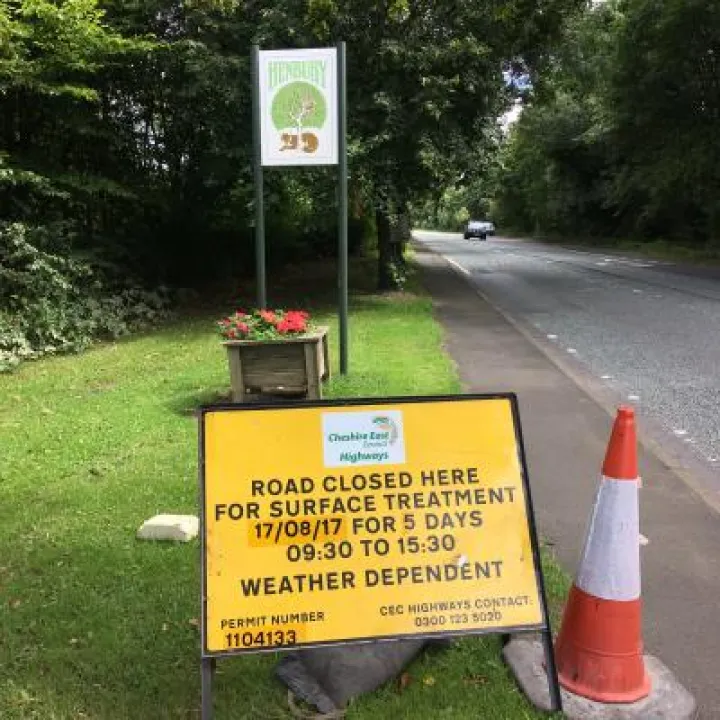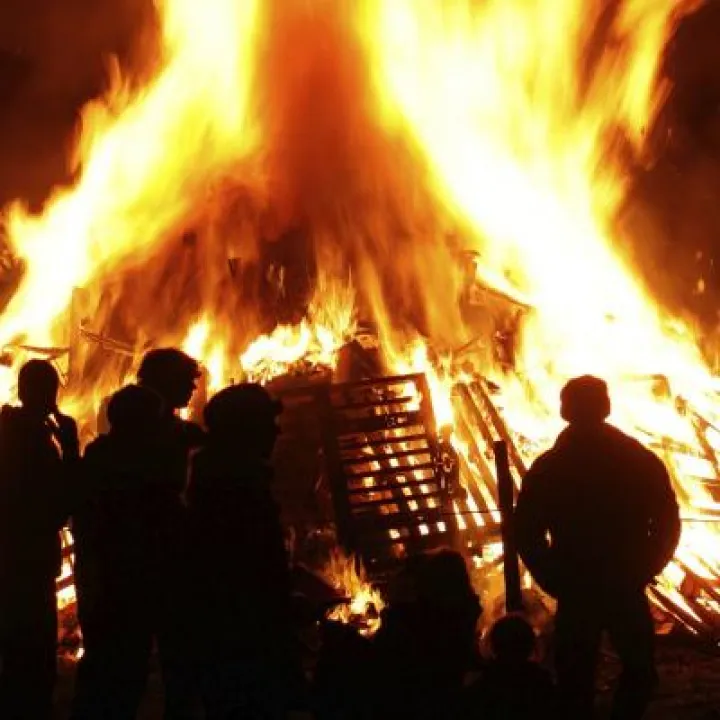







Our regular contributor "Horrid of Henbury" continues his delightful monthly notes of what he's spotted around the village.
If you enjoy reading these notes, or if you spot anything you think readers might be interested in – please do let us know. Email: editor@henbury.org
"The Glorious First of June"! The Anniversary of the battle of Ushant in 1794 when Admiral Lord Howe's fleet vanquished a French fleet in the first big naval conflict of the Napoleonic revolutionary wars. The French still like to call it a draw but their fleet was blockaded in port for years. When it finally came out in force in 1805 the result was the Battle of Trafalgar (having done "O" Level History the date always comes back!).
The month started a bit grey but not cold. Then the sun came out. The kestrel reappeared over the fields (reassuringly after the building development) but seemed not to find any prey. Dot the Dog found a huge number of things to investigate in and under the hedgerows so I carried her ball for much of the time. The scent from the hawthorn blossom remained heady and almost overpowering (I wonder if there is an as yet undiscovered anaesthetic or hallucinogenic chemical compound there). As dusk fell the thrush burst again into full song.
On the Millennium Green the marsh orchids were in full flower – deep purple spikes as the ox-eye daisies began to open and the ragged robin showed up. Yellow rattle was suppressing the more aggressive grasses so the flowers had air and light. For the moment meadow buttercup held centre stage.
"Flaming June" arrived – the containers in the garden needed water and our little pool had to be topped up – but the tadpoles really enjoyed the sunshine!
"Flaming June" flamed on. The big field flood had just about dried out. In the hedge along the track from Anderton's Lane to Moss Cottage and Mossways the first dog rose was out, and a little further on in the bottom of the hedge was a small clump of starry white flowers. I stuck a stem in the band of my Panama hat to take home and identify – as suspected they were "Star of Bethlehem", so a garden escape. Dot the Dog was most impatient at my delay!
The cattle were still in the big field but it looked nearly grazed out. They seemed quite content, lying in the sun. A pair of steers jousted – having been dehorned it was head-to-head pushing and shoving.
Then a grey, cooler day. Went to the Millennium Green for a look round. The marsh orchids were splendid and everywhere, the Ladies' Bedstraw behind the sundial was proliferating and the nearby cowslip was in seed. Some early dog roses were out (one had scrambled through the Ashmead's Kernel apple tree nearly to the top). Deep pink downy roses were splendid.
A melanotic pigeon visited the garden – dark plumage all over (presumably an autosomal recessive gene mutation of which it must have two copies). It, or its near relative came a few times last year. It's quite aggressive and well capable of seeing off magpies!
People think grass is green (their own manicured lawns). If you go over the fields in mid-June you'll see something quite different – a landscape of red and yellow. The yellow is field buttercups. The red is the flowers on knee-high mature meadow grasses – timothy and meadow foxtail in particular. There are so many other grasses there too – perennial rye grass, Yorkshire fog, cock's foot. Dot the Dog loves ferreting around in the long grass looking for mice and things – the grass is taller than her. There are obvious runs however that DtD and I explore where fox or badger do their nightly rounds, quite distinct from the wide trampled paths made by unadventurous dogs and their equally incurious walkers...
Heat returned. The cattle were released into the big flood field over by Whirley Road (no flood now!). The beasts had clearly liked sleeping under the cover of the trees – the grass beneath the oak (by the kissing-gate into the field behind the school), the lime a bit further east and the horse chestnut at the gateway into the little top field was flattened where they had lain. Booby traps had been laid... The colourful red and green vista I mentioned the previous day was already under threat as serious grazing began...
The following morning was already fearfully hot by dog-time. Dot the Dog and I set off for our everyday walk but turned back at the kissing gate into the flood field – DtD decided it was too hot to go further and the cattle were huddled under the oak tree so densely I thought that if we startled them we might be crushed as they moved. A couple of them stuck their noses through the fence and introduced themselves to DtD, who to my surprise made friends and walked on. There is a particularly handsome and friendly beast, brown and white with a pair of brown spectacles and impeccable manners, that I'd love to bring home...
You (I) might have anticipated that my early morning watering of the vegetables would herald a torrential storm (sod's law is infallible) – it did!
Mid-month interesting things happened in the big flood field. A middle-sized digger appeared, parked by the gate into the little top field. Next day it was accompanied by a few short lengths of plastic field drain (quite a large bore!). The flood area and the surrounding rush beds sprouted a number of what looked like surveyor's poles. It transpired that people were trying to find the ancient field drains in order for them to be replaced, so as to reduce the flooding behind Henbury Rise and William's Way.
Fresh fox spraints and a scattered pile of fur suggested that Brer Fox and family had had a good meal...
Rain came at last. First a torrential downpour not much use because the ground was so dry the water just ran off. Then a day of gentle, persistent rain that penetrated the crust. The plants loved it!
Some bird observations. A "feral" pigeon (more politely known as a Rock Dove and ancestor of woodies and racing birds et al) appeared in our garden and seemed on good terms with our usual gang of wood pigeons. Dot the Dog chased them off vigorously! Over the fields DtD and I met a partial albino crow – all black but for a white patch on its back. We saw another a year or two ago with a white patch on one wing. Magpies fed young around the bird feeders and blue tits (and we think coal tits) did likewise (but scooted off when the magpies arrived).
The longest day arrived, hot and sticky again. Soaked walking home from the church hall by a torrential shower. More followed. A meadow brown butterfly crossed DtD's and my path on the afternoon walk but butterflies seem in short supply this summer. There was a pigeon's egg obviously plundered by one or other of the corvids lying in one of the fields. Both Dot the Dog and I were beginning to flag in the heat and humidity by the time we had done around three quarters of our usual round and I began to wish for another soaking!
Our bee houses have proved very fruitful – literally. The broad beans are laden and the courgettes started cropping.
Small brown toadstools appeared on the track from Anderton's Lane to the cottages. They are apparently "Brittlestems", of the ink cap family. A very useful app on my phone (Picture This) can identify more or less anything that grows within seconds and I cheat shamelessly else I wouldn't have known their identity!
Dot the Dog discovered some fresh(ish) fox spraints again over the fields – I was dragged mercilessly following the scent until she lost it on the way over to Whirley. En route another hapless bunny had evidently met a sticky end...
A juvenile greenfinch explored the seed feeders, as did a young long-tailed tit and a bullfinch – they must all be breeding nearby. Jackdaws plundered the peanut feeder but while they digested their feast the woodpeckers took advantage and had a good meal too. Unusually for summer siskins also came to feed.
The tadpoles gained legs and became recognisably froggy, although their vestigial tails had not yet been completely reabsorbed. They couldn't have been more than 9 or 10 mm from end to end but "left home" in the last days of the month – we suspect the jackdaws are feasting.
On the banks and stone walls along Anderton's Lane, there were masses of pennywort flowers and there was nipplewort down towards the bend by Mount Farm. The latter found a comfy niche too in our front garden beside the beech hedge – rather pretty so not "weeded out"...
End of the month. Four swallows swooped and dived over the fields – perhaps attracted by the flies hanging around the cattle. Evidence of dung fly activity appeared as bore-holes in the cow-pats. Dot the Dog and I watched a buzzard that was presumably breakfasting on carrion on the field floor being chased off by a very aggressive crow. The crow was probably interested in the same bit of carrion, most likely a fox-killed rabbit or pigeon – although they are "birds of prey" buzzards seem quite timid despite their size.
S and I watched Mrs Woodpecker showing her juvenile how to feed from the seed feeders. She had found that she could reach the feeding ports even if she had to perch on the outside of the "squirrel-proof" wire cages that surround them and allow only small birds inside. We hoped the sparrowhawk didn't notice. A day or so later the juvenile, sporting its red schoolboy cap, came to try for itself and seemed successful.
I have been asked why I don't add pictures to these notes. Answer – I'd rather any readers went out and looked at what there is to see for themselves. If you think I'm an expert – I'm not – I come home and look stuff up in my 1983 Readers' Digest Guide to Britain's Wildlife, Plants and Flowers ! It's a mine of information, as are the ancient Collins Gem guides (the newer editions are significantly dumbed down). Nowadays some people instead of asking us on our morning walk if we've seen anything will tell us what they have seen – very annoying if DtD and I have missed it (but at least some people seem to read my meanderings)!
As ever
Horrid of Henbury

